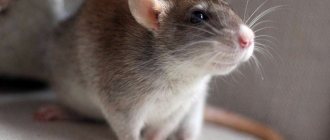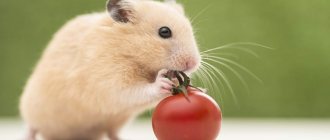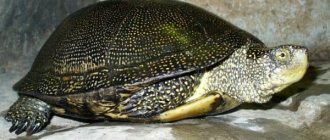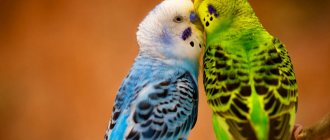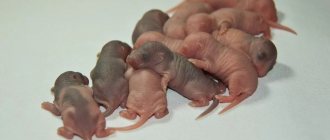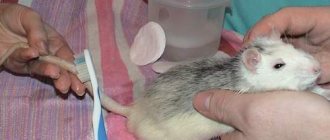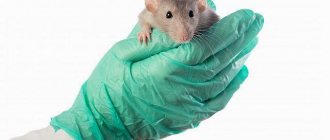An inexperienced owner of a pet rat may not even be aware of the imminent replenishment of his pet’s family, in which case the discovery of a whole brood of naked squeaking lumps in his pet’s cage may come as a complete surprise to him. Sometimes, owners purposefully breed a female rat to produce rat offspring at home.
What do newborn rat pups look like?
Newborn rats, of course, cause affection and a surge of tenderness, but now all worries about the nursing mother and her children fall on the shoulders of the rodent owner.
The baby rat looks very cute and touching, resembling a pink celluloid baby doll with pink skin and a large round head. Little rat pups are completely hairless and are born blind and deaf, although the sense of smell and instincts in these touching babies are already developed. By smell, the cubs find their mother's nipple, gorge themselves on nutritious milk and fall asleep near the warm belly of the female.
On the large head of a small rat, through the translucent skin, you can see huge dark balls of eyes, which indicates the dark color of the animal. If the contours and color of the baby’s eyes cannot be determined, then the rodent’s fur will be light: red, white or yellow.
A newborn rat pup is very small and defenseless, the weight of the pup at birth is only 3-5 g, the body length of females reaches 5-6 cm, males - up to 9 cm.
IMPORTANT!!! Newborn rat pups should not be touched. The baby’s body is very fragile, one awkward movement can kill the animal. The rat will also not accept a baby with the smell of human hands; excessive curiosity of the owner can result in the death of the baby.
Preventive measures
To prevent mice from wanting to settle in a house or apartment, it is necessary to deprive them of the opportunity to find food and modest corners. All products must be hidden and garbage must be taken out. Place cotton pads with a few drops of essential oil of mint, wild rosemary, and wormwood in the corners.
Things need to be shaken up, neatly folded and closet doors closed tightly. Arrange wild rosemary and wormwood branches.
It is necessary to clear pantries and other places of trash and unnecessary things. Keep books on closed shelves. Fix all water leaks.
Regularly wipe the floors with vinegar or turpentine. Throw out the trash and wash the bin to remove odors.
Little gray mice look very cute. But…!!! They are a source of infection and very often are carriers of many diseases that can be dangerous for humans and often incompatible with life. High fever, severe headache, shortness of breath, lethargy or confusion, a rapidly spreading rash, sharp pain in the lumbar and kidney areas are obvious symptoms of mouse fever in adults.
According to analytical information from the Center for Disease Control and Prevention, a number of infectious diseases are transmitted to people from rodents (field mice, rats, squirrels). Adults suffer the course of the disease much more severely than children. Their body is characterized by the appearance of extensive symptoms and the development of various complications, while sometimes it can only occur like a cold. Men aged 16-50 years are most susceptible to infection.
Incorrect or late diagnosis, incorrectly selected treatment or lack thereof can lead to death. Although there is no cure for the virus itself, supportive therapy makes it easier to cope with the disease.
Mouse fever
– a natural focal rare infectious disease with an acute course (hemorrhagic fever, accompanied by renal, pulmonary or cardiac syndrome), where the reservoir of the pathogen is an animal (rodent class).
The causative agent of the disease
: Hantavirus, having different strains.
Affected areas
: small vessels, renal apparatus, lungs, heart.
Geography
: A variant of the virus is common in Eurasia that causes renal syndrome, i.e. affects the kidneys. In this case, the disease has a medical name (HFRS), leading to mortality in 10% of cases. Epidemic nephropathy (EN), which is one of the types of HFRS, occurs mainly in Scandinavian countries, but its mortality rate is several times lower.
An infected rodent carries the infection for two years. And it is assumed that only certain types of virus can kill them too. In other cases, the virus does not pose a serious danger to the rodent.
Hemorrhagic fever with renal syndrome is a rarer type of mouse fever, which occurs mainly in America. But, according to statistics, it leads to death approximately 7 times more often (76%).
Demography:
Anyone can get sick, but men aged 16-50 are at greater risk.
Incubation period
on average it lasts 12-15 days, but the individual tolerance of an adult, as well as the state of the immune system and predisposition to resistance, can increase the incubation period from up to 8 weeks.
Severity of the disease:
varies depending on the virus causing the disease. Infections caused by the Hantaan and Dobrava viruses tend to cause severe symptoms, while the Saaremaa and Puumala viruses are more easily tolerated. Full recovery may take several weeks or months.
Since we usually have murine fever, accompanied by renal syndrome, the article will focus mainly on it.
How a rat takes care of its pups
Rodents by their nature are excellent mothers; a rat spends the entire day with its pups, tenderly caring for, feeding and caring for the babies. The female covers her large brood with her body all day, warming and protecting the cubs. The warmth of the rat's body and frequent feeding with nutritious milk stimulate the development of all organ systems of small animals; it is almost impossible to feed and keep newborn babies alive without the care of the mother.
Sometimes a rat produces a litter of 15-20 pups
, some of the stronger cubs more often than others end up near the nipple with milk, the rest of the pups may die without feeding. In such cases, in the second week, you can place briefly fed nimble babies in a separate container, maintaining a constant temperature of 39C in it; for this purpose, you can use a heating pad or bottles of warm water.
At birth, baby rats cannot empty their bowels on their own; the mother often licks the babies' bellies, stimulating bowel function and removing newborn feces.
A small rat is a completely hairless creature; the body of a tiny animal becomes overgrown with fur only in the second week of the rodent’s life. Decorative rat cubs are not able to maintain a constant body temperature, so naked babies physically cannot survive without the warm belly of their mother.
If the mother leaves the newborns for a few minutes, the body temperature of the pups instantly drops, they stop moving and fall asleep. The mother carefully monitors the body temperature of each baby all day, and if necessary, the rat changes places between the children.
The rat gradually reduces the time spent near children, adapting newborns to environmental conditions and independently maintaining normal body temperature. If at birth the female practically does not leave a brood, then by the end of the first week the babies spend a third of their time without their mother, with a further increase in their independent period.
Keeping decorative rats at home
Despite the compact size of the pet, this does not mean that you can neglect caring for your decorative rat.
Like any pet, a domestic rat needs a certain diet, a place to live, and it is also worth considering the presence of other pets before getting a pet. When purchasing a rat, you need to immediately think about where it will live. The only correct answer is a cell. For one individual, the size of the cage must be at least 30*50*40 cm; if the number of animals is larger, then the size of the dwelling increases. Interestingly, it is better for males to choose wider cages, and for girls - higher ones.
Do not load the cage with multi-story structures in the hope that the rat will find it more interesting. It’s better to build hammocks inside, put a couple of ladders, a wheel or a swing. The cage must have bedding: for example, made from sawdust (not pine wood!), you can also use corn or wood litter for cats or a special one for rodents.
As a budget option, you can take white paper, but not newspapers - rodents can be poisoned by toxic paint! The cage in which the animals live should be regularly removed, cleaned and the filler changed as necessary.
A prerequisite for proper maintenance of decorative rats at home is regular walking. While walking, remember a few important rules:
- put all valuable small items out of reach;
- many domestic rats like to chew and damage wires, so make sure that chargers, headphones and other equipment components are not left unattended;
- Make sure that all small animals are out of the animal's reach. Thus, these rodents are capable of attacking smaller rodents of other families, are able to climb into aquariums, and show aggression towards smaller animals.
dog
Important! Males and females must live exclusively in separate cells, otherwise uncontrolled reproduction and numerous offspring are guaranteed! Animals of different sexes also need to be walked at different times.
diet
- vegetables (zucchini, pumpkin, beets, zucchini, carrots, cucumbers, bell peppers);
- greens (basil, cilantro, onion, parsley, lettuce, celery, dill);
- fruits and berries (apricots, pineapples, cherries, melons, strawberries, apples, plums, peaches);
- combined grain feed (millet, barley, oats, buckwheat, rice);
- gammarus, seafood (boiled);
- dairy products (cottage cheese, kefir, fermented baked milk, yogurt, cream);
- meat products (rabbit, poultry), including offal, but only in boiled form;
- chicken eggs and fish (boiled).
So, what is forbidden to feed a decorative rat:
sausage and other prepared meat products (they contain a lot of spices and additives);
lard and deli meats;
from dairy products you should avoid sour cream, butter and condensed milk
Regular milk should be given with caution, as there may be intolerance to it; It is better to remove the seeds from fruits and vegetables. They are difficult to digest and may contain substances harmful to the animal;
citrus fruits are prohibited in the diet of rodents;
some fruits should be given with caution and not overdo it: bananas, grapes, avocados, pears, kiwi
Some of them are too high in calories, while others contribute to gas formation;
dried fruits should be supplied in very limited quantities;
beans, beans and peas strongly stimulate gas formation, so they should be excluded from the diet;
among vegetables you should avoid turnips, radishes and cabbage of all types;
potatoes must first be thermally treated;
It is strictly forbidden to give store-bought sweets, jam, honey, and baked goods.
Did you know? Rodents have teeth that grow throughout their lives, so they urgently need to regularly grind them down on hard and tough objects.
- if the animal is old and cannot fully care for itself;
- if the rodent is very dirty;
- if you haven’t cleaned the house for a long time, and the rat didn’t take care of itself carefully enough;
- if the animal has parasites that need to be removed.
Development of baby rats by day
Newborn rodents grow very quickly, a defenseless blind lump becomes an adult after 4 weeks, males reach sexual maturity at 5, and females at 6 weeks. The development of rat pups day by day is as follows:
1st day
Immediately after birth, the pups are naked, pink, blind and deaf babies with underdeveloped limbs and a small tail, who can only squeak, suck and sleep.
3-4th day
The cubs' ears open, and now the pups can distinguish not only smells, but also sounds.
5-6th day
The bodies of newborns begin to be covered with the first soft hair, the skin has become flesh-colored with dark spots, the presence of which determines the color of rodents.
8-10th day
The baby rats are erupting their first teeth, the babies are already covered with short velor fur, the cubs are becoming very nimble, they start fights over the mother’s nipple, their movements are not yet fully coordinated.
12-13th day
The babies' eyes open, the pups explore the territory, actively try to get out of the nest, but the rat diligently returns the children to their original place.
14-16th day
At this time, secondary sexual characteristics are formed and the sex of the animals can be determined; in females, nipples are visible on the abdomen.
16-18th day
Babies actively begin to taste their mother’s food, try to gnaw all surrounding objects, from this period the first complementary foods of animals can be introduced.
20-27th day
The cubs are practically independent individuals, feed on the food of adult animals, milk production declines, and lactation stops by the 27th day of the babies’ life. A physiological feature of rat pups is that during this period they eat the female’s feces and become accustomed to the mineral composition of the adult diet. The rat stops dragging newborns and takes care of the offspring less and less, teaching children to be independent. The babies are still attached to their mother; it is not recommended to separate them during this period.
28-30th day
The pups are already adults, they are curious about everything new, the kids begin to recognize people and play with their owners. In the wild, at the age of one month, rodents already become independent hunters, and provide their own food and housing.
How is it different from a mouse?
Newborn rodents of different species are often confused with each other. The little ones are very similar to each other, but there are still many differences between them. An attentive person will quickly determine by the appearance of the babies exactly whose nest he was lucky enough to discover.
Rat cubs from mice are distinguished according to the following criteria:
- Size. The body of a newborn baby rat will be longer than that of a mouse.
- Muzzle. In a baby rat, it seems to be chopped off and has bulging eyes covered with skin.
- Ears. In the vole they are round and large.
- Tail. Mice have a long and thin tail. It is equal to the length of their body.
The baby rats in the photo will be larger in size. They are slightly thicker and darker than a newborn vole.
When baby rats open their eyes
Little rat pups are born completely blind and deaf; for the first 12 days of life, the cubs are guided only by smell. Later, in adult life, the rat uses its sense of smell to explore the entire environment. Scientists have proven that episodic memory in rats is structured like that of humans; the animal is capable of not only capturing and distinguishing different notes of odors, but also of associating situations of their occurrence and manifestation. The first aromas that a newborn smells are the smell of milk and the body of its mother.
The eyes of rat pups open on the 12-13th day of life, the babies begin not only to smell, but also to see the world around them.
From the moment their eyes open and they gain the ability to see the world around them, rat cubs begin to actively leave the nest and explore new territories. Rats' eyes are located on the sides of their heads; this anatomical feature gives them a wide viewing angle. The animal, without turning its head, can look with both eyes in different directions, even up, back and down. In this way, nature protects wild rats from attacks by predatory animals and birds.
What to give and what not to give
Rodent owners lacking experience are often faced with the problem of organizing a diet for their pets. Below you can find a list of the most popular questions regarding the topic of feeding and the answers to them.
Bread
What do ferrets eat in the wild and at home - food list
Bread and cookies can be given to your pets as a rare treat. However, before feeding the animal, you should dry the flour product in the oven.
Important! The product should not be burnt or contain a high percentage of sugar.
Kiwi
Kiwi is an excellent source of moisture, but it is best not to add it to the daily diet of rodents. You can only give your pet fruit cut into slices a few times a month.
Tangerines
Tangerines can cause serious allergies. However, not every rat can be harmed by citrus fruits. You can try giving a small piece of tangerine for the first time and monitor the well-being of the gray rodent.
Grape
Rats really love grapes. Sweet and high-calorie raw berries should be given to your pets with extreme caution. Eating large amounts of dried or fresh grapes can cause the development of gastrointestinal pathologies.
Eggs
Eggs can and should be given to rodents. It is best to feed your pets quail products. Eggs should be present in the diet no more than 2-3 times a week.
Dates
Dates contain a large percentage of beneficial microelements, vitamins and minerals. Such food will be useful for rodents. However, dates should be present in the diet no more than 2 times a week.
Cheese
Cheese can only be given to animals as a treat, as such a product can cause obesity.
Fruits
Fruit can be fed to rats up to 5 times a week. At the same time, you should be especially careful when giving a pear, which can cause constipation.
Not every fruit is good for an animal
Caring for newborn rat pups
A rat cub is a defenseless, touching creature that requires increased care from its mother and owner. The mother will take care of the feeding and hygiene of the babies; the owner needs to properly care for the female and her offspring, without interfering with physiological processes. To do this, it is advisable to create comfortable conditions for newborn rat pups:
- In no case should you pick up or examine the cubs; the female may abandon or eat the brood from stress;
- the cage with the rat litter should be in the quietest, warmest and driest room;
- The rat cleans the nest on its own, throwing dirty pieces of bedding into the corner of the cage; the owner constantly needs to give the female clean napkins. You can remove used napkins from the cage no earlier than the 8th day of life, without touching the nest. If the rat becomes agitated when cleaning, put it down;
- watch the cage door, the cubs after the 8th day are very nimble and can jump out and crash on the floor, or the female will drag the newborns to any quiet corner of the apartment;
- feed the female with nutritious food and keep the drinking bowl filled with clean drinking water;
- Carefully introduce healthy complementary foods to babies for the proper development of the digestive system of newborns.
Possible problems and complications
Typically, rats cope with labor on their own and do not require additional assistance. However, no one is immune from possible complications. The following signs indicate problems:
- bloody or purulent vaginal discharge;
- complete absence of movement when palpating the abdomen before childbirth;
- animal apathy, refusal of food and water;
- prolonged labor – longer than 5 hours;
- the female gave birth to several babies, but does not show attention to them - probably several more rat pups got stuck passing through the birth canal.
If you detect at least one of the listed signs, you must immediately take your pet to the veterinary clinic. Surgical intervention may be required to save the rat.
Sometimes rat pups are born in the amniotic sac, and the weakened mother is not able to free the newborns on her own. In such a situation, you should not waste time going to the veterinarian - you can help the furries yourself. To do this you need:
- clean your hands with alcohol;
- wrap the index finger and thumb with a sterile bandage;
- gently pick up the baby in the shell with bandaged fingers;
- with the other hand, cut the amniotic sac using nail scissors and release the baby rat;
- use gauze to remove accumulated mucus from the baby’s mouth and nose.
If all manipulations are carried out correctly, the little rat should squeak. You will also need to cut the umbilical cord and treat the wound with chlorhexidine.
When can you pick up baby rats?
Touching baby rats immediately after birth is highly discouraged! The mother can eat a baby with a human smell, and there is also a chance of accidentally damaging the newborn’s thin bones.
Towards the end of the second week of life, you can briefly remove the newborns from the nest in the absence of the female, examine the pups and determine the sex of the animals. It is advisable to do this while wearing medical gloves or thoroughly washed hands so that the female does not abandon the brood.
From the end of the second week, you can take the babies out of the cage, often in the presence of the mother, so that the rat trusts you and does not worry about the children. Rats at this age are unusually nimble and inquisitive, while the female is on a walk every day, it is advisable to accustom the rats to friendly human communication: carefully carry in two palms, stroke, talk in a gentle voice, wear in the sleeve and in the bosom. Wary tiny animals quickly get used to people and begin to trust them.
IMPORTANT!!! Lack of active close communication with a person at a young age can make a pet fearful or aggressive towards humans.
Location
Where the black rat lives is a very interesting question. The favorite habitat for the rodent is sea vessels. Rats live side by side with humans and eat identical food. They spread around the globe thanks to water transport.
The black rat is less inventive than its relative the Pasyuk. Content with little. Settles near reservoirs and rivers. But it is less attached to water than the gray one. Does not build nests in the ground, avoids water, but if necessary, swims quite a long distance. It does not dive because fish, fry, and amphibians are of little interest to it.
Willingly settles in the forest, fields, and edges. The lifestyle is more reminiscent of voles. In urban areas, it prefers sewers, abandoned buildings, garages, garbage cans, and entrances. Can live in a person’s house, occupying the upper floors or attic.
When can you give away baby rats?
From 2 weeks of age, it is advisable to frequently pick up babies and give them treats from your hands.
, the animals will get used to doing without their mother and will remember the smell and voice of the owner. While feeding, the baby rat may bite its owner, mistaking its finger for a treat. It is absolutely forbidden to raise your voice in such cases and scare the baby.
At 5 weeks, males must be separated from their mother in a separate cage to avoid uncontrolled mating: an adult female can become pregnant, and from 6 weeks, young females can become pregnant. If possible, it is useful to keep boys with their father and girls with their mother; the cubs learn the life skills they need from adults. In the wild, rats also live in same-sex packs. Babies can be kept near a female or male for any length of time, taking into account the size of the cage and the number of pets.
After jigging, the young animals can be completely transferred to adult food, adding greens, vegetables, fruits and fish oil. At first, it is useful to feed babies with cow's or goat's milk from a pipette.
At 5-6 weeks of age, you can give away rat pups; it is highly not recommended to do this before 4 weeks of age; the cubs during this period are still breastfed; early weaning can negatively affect the health of the rat pup. A late change of owner is also undesirable; adult individuals get used to the owner and experience stress when the environment changes.
Birth
At the second stage of being in an interesting position, it is not recommended to disturb the female, namely:
- move the cell;
- pick up and so on.
This leads to termination of pregnancy.
In the process of bearing offspring, the female needs rest and a balanced diet.
The total gestation time of a rat is 23 days. By the time it ends, a number of hormonal changes are completed in the animal’s body. As for the external features of hormonal changes, they look like this:
- The female becomes somewhat nervous at the sound of someone else's baby squeaking.
- The creation of a nest for delivery is carried out by the animal independently a couple of hours before the start of the process.
- An interesting thing is that if during this period you place someone else’s baby next to the female, the expectant mother will accept him with great pleasure, despite the fact that she has not yet produced milk.
- During this period, the animal’s hostility towards any other animals increases significantly.
The female needs rest during delivery. Fear leads to spasms of the uterus and can provoke the death of an adult. Pathologies during delivery occur due to the non-standard position of the fetus. Often, the death of a female in the prepartum position occurs due to the decomposition of the non-surviving fetus or during pregnancy outside the uterus.
The traditional duration of birth for a rat is 2-3 hours. Before delivery, bloody fluid is released from the female’s perineum, after which the animal feels a contraction. The body is stretched and the sides are stretched to the limit.
Before the immediate appearance of the rat pups, the female sits down and assists their exit using her paws and teeth. The animal also pulls out the birth sac on its own, and then proceeds to the pups: licks them and gnaws the umbilical cord of each one. Experts note that after birth, the animals eat the placenta and umbilical cord. During the birth process, the baby begins to move and make sounds; these kinds of signals show the female that he is viable, and she cannot eat him.
Features of behavior
The character of these animals cannot be called simple. Siamese are characterized by alertness. If the animal has a bad upbringing, then it may attempt to bite its owner. This behavior needs to be stopped and try to find a common language with your pet as quickly as possible. To do this, you can use the following tips:
- from childhood, an animal needs to be picked up, talked to, called by name, so to speak, tamed and established contact;
- aggressive behavior of a rat can be stopped by light blows on the face, shouting or clicking on the nose;
- from the first minutes of communication you need to show that you are in charge.
Coat color
There is a wide variety of colors and coat tones for decorative types of rats. Based on this criterion, they are divided into groups.
Homogeneous
With uniform coat color in decorative rats, all hairs should look the same and be the same color.
The following colors are available:
- black;
- white (albinos);
- Russian blue and smoky blue, which differ only in the intensity of the tone;
- brown-gray;
- platinum;
- beige;
- champagne
There are several types of light gray color:
- with a blue tint (Russian silver);
- with a pink tint (dav);
- with a chestnut tint (lilac);
The name of the color is also determined by the color of the eyes. For example, rats with champagne coat colors should have pink eyes. And in white decorative rodents they are red and black.
Ticked
Each fur of such a rat is colored in several colors:
- Agouti. The basis of the classic color is soft brown hairs with black tips. A silver-gray tone predominates on the belly. Blue agouti is characterized by a combination of brown with silver or cool blue color. The platinum agouti has light gray and beige hairs that are effectively complemented by a blue tint.
- Amber. An ivory band is visible on the orange and fiery yellow hairs. The undercoat is a delicate cream color, the eyes are pink.
- Cinnamon. On the back, red-brown hairs with a bright golden edging predominate, and on the belly, gray and silver hairs predominate.
- Faun. The predominance of coffee-golden color, the silvery tint to which is given by guard hairs. The fur in the belly area is silver-cream in color. Fauns have dark ruby eyes.
- Topaz. Light coffee hairs are combined with silver ones. In color, these rats resemble fauns, but have a lighter shade of undercoat, due to which the entire color of the coat appears less saturated. Most often, they can only be distinguished by specialists who know what color these two types of rats are.
- Pearl. The color contains beige, golden and gray shades. The belly is sandy, with a grayish tint.
Silver
A peculiarity of this type of rat is the combination of hairs colored silver and other colors in equal proportions. The fur of such rodents must shine and sparkle.
A silver tint can set off a black, blue or brown tone.
Combined
This type includes rats whose color contains 2 or more shades:
- Siamese. The rodent's fur is beige in color, which becomes more saturated in the back of the body. The tail is uniformly dark. Brown spots are located on the face, ears and the bottom of the paws.
- Himalayan. The uniform snow-white coat has dark brown spots. A special feature is the red eyes. Black-eyed Himalayan rats have cream-colored spots.
- Burmese. The main coat color on the body can vary from sandy to brown, with darker spots on it. The tummy of rodents is distinguished by a gray-white color.
- Sable. The coffee color is combined with dark brown spots on the limbs.
Rats that combine white and colored parts of their fur in a certain order are called marked. The marking may take the form of a cloak, hood or train.


